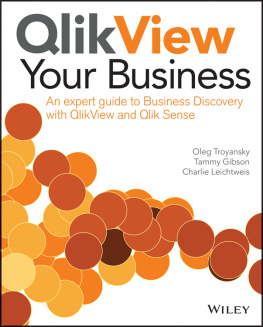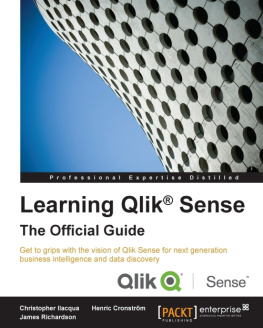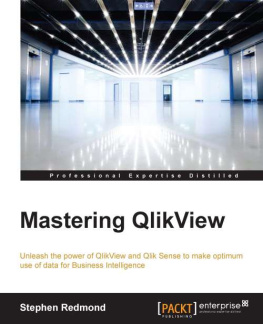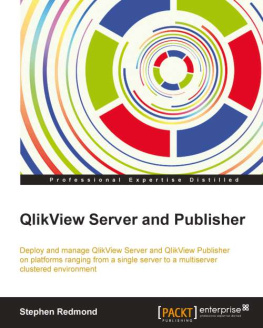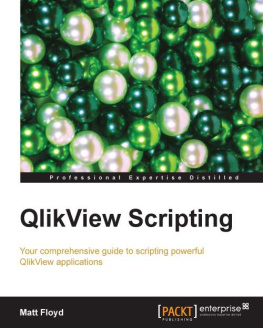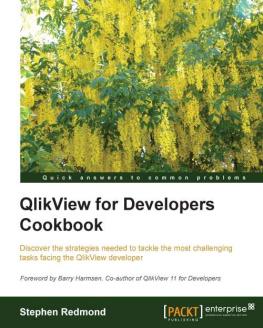
I
Getting Started
- Chapter 1: The Needs and Challenges of Business Intelligence and Analytics
- Chapter 2: Why Use Qlik for Data Discovery and Analytics?
Chapter 1
The Needs and Challenges of Business Intelligence and Analytics
Every day we are confronted by the challenges of our business, whether we work in the boiler room or the board room. We worry about how to make things work in the best possible way and we worry about avoiding mistakes that can cause things to go wrong. There are a lot of moving parts to any business and it takes a number of people to monitor and manage those moving parts. The fact that there are challenges to managing your enterprise is not a new revelation. Challenges are the main reasons we face some amount of stress in our jobs each time we care enough to get it right. The question is not just, What am I supposed to be doing right now? but, Where are the current and potential problem areas that will prevent me and my business from succeeding?
This chapter begins to address those questions and provides some insight into the ways this book will help you answer them. You will learn what business intelligence (BI) is, and the analytics that drive an understanding of the strengths and opportunities that exist in your business.
The Case for Business Intelligence
The issues that keep us up at night include what we dont know about our business as much as what we do know. For example, one company experienced a 30% drop in sales in a period of two and a half years. Its true that they knew what customers they lost. In fact, they lost all of their mass channel retail accounts in North America. They were also told by the accounts that they were being dropped because of lack of service and poor unit movement of their products on the shelves of the retailers. The company involved, who shall remain nameless, knew they had a big problem, yet they never saw it coming. They didnt know exactly what the problem was. They didnt know what the root cause of the problem was, and most importantly, they didnt know how to fix it! In this case, a significant problem was service level. The company never calculated service level performance, which is the measure of on time and complete delivery to customers.
On Time and Complete Delivery
This metric measures the count of orders delivered complete and on time, divided by the total count of orders. In the example here, this measure was below 40%, which means that 60% of the time the company did not deliver the order with the right quantities or in the time frame required by the customer! The requirement for compliance with mass retailers is a minimum of 98.5% on time and complete.
The company failed to service customers because they did not have proper measurement systems in place for many of the major processes of the business. Data that was needed for proper measurements was buried in functional silos, which meant lack of visibility and communication across functions or to the organization in total. Does this sound familiar? If it does, you are definitely not alone!
The lack of an accurate forecasting process prevented the company from meeting service requirements. Forecasting is an example of a major process that must be connected to other major processes of the organization in order to be successful. When its based on a good understanding of your customers, forecasting will positively impact your production requirements, inventory accuracy, and purchasing requirements. The companys failure to have the right measurements and its failure to connect the information from these key processes led to blind management and an unacceptably poor customer service level. Poor service in turn led to a catastrophic loss of business.
NOTEYour companys situation may not be as severe, but are you sure about what is going on in your businessgood and badand aware of what needs to be done about it in a timely manner?
The question posed in the chapter introduction was, Where are the current and potential problem areas that will prevent me and my business from succeeding? This can be very difficult question to answer. And yet, your ability to answer the question positively may be the difference between the success and failure of your company. Running a successful business certainly takes having the right people in the right places in your organization. With that, it is also critical that you have the right data and the ability to access and share that data across your business.
Business intelligence has evolved as a significant segment of the information technologies market by helping companies answer these fundamental questionsHow do we know whats going on in the business? What needs to be done about it sooner rather than later? How can we maximize what we know and learn more about what we dont know about our business?
In the early days, business intelligence was a luxury, only available to the biggest and the richest companies. Today, even midsize and small companies use business intelligence tools and analytics to enable their people to make informed decisions on a timely basis. BI has become a critical component in the mix of tools and processes that companies use to maximize their businesses potentials and avoid costly pitfalls.
Common Challenges of Business Analytics
Throughout history, businesses have faced significant challenges that threatened their relative success and even their existence. In addition to economic cycles, competition, and regulations, significant challenges frequently faced by businesses include having accurate and timely data about:
- Who their customers are
- What their customers' needs are
- How their customers make purchasing decisions
- How to reduce the cost of products and the cost of servicing their customers
The enterprise that successfully unlocks the data necessary to make timely, accurate decisions about these challenges is better equipped to create sustainable, profitable growth.
Every company, regardless of the segment of the market that they sell to, is challenged to make sense of large amounts of historical and live data across their various data sources. There are a number of barriers that impair a companys ability to effectively connect the dots between mission-critical processes and make timely decisions that positively affect sales, operating income, return on investment (ROI), and cash flow. Because of this reality, business intelligence and analytics are critical areas for technology investment.
There can be significant barriers to successful decision making in a variety of business scenarios, including:
- Manual processesManagement reporting using cumbersome spreadsheets that are labor intensive and too slow.
- Functional and data silosThe need to integrate information across key functions and multiple locations makes the process even slower.
- Fragmented view of the businessThere is no ability to easily and accurately create a corporate-level, single-view dashboard of the business in a timely manner.
- Data qualityData correctness across different data sources is in question, resulting in significant time spent reconciling data from various sources.
Do these barriers sound familiar to you? These barriers affect the accuracy and timeliness of connecting critical business processes, which impact customer-facing activities, and ultimately impair the enterprises ability to optimize sustainable profitable growth.
Next page
